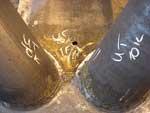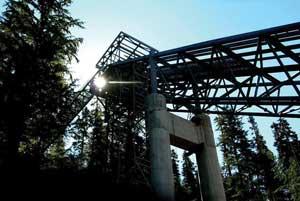Senior Editor
- FMA
- The Fabricator
- FABTECH
- Canadian Metalworking
Categories
- Additive Manufacturing
- Aluminum Welding
- Arc Welding
- Assembly and Joining
- Automation and Robotics
- Bending and Forming
- Consumables
- Cutting and Weld Prep
- Electric Vehicles
- En Español
- Finishing
- Hydroforming
- Laser Cutting
- Laser Welding
- Machining
- Manufacturing Software
- Materials Handling
- Metals/Materials
- Oxyfuel Cutting
- Plasma Cutting
- Power Tools
- Punching and Other Holemaking
- Roll Forming
- Safety
- Sawing
- Shearing
- Shop Management
- Testing and Measuring
- Tube and Pipe Fabrication
- Tube and Pipe Production
- Waterjet Cutting
Industry Directory
Webcasts
Podcasts
FAB 40
Advertise
Subscribe
Account Login
Search
Gold medal fabrication for Olympic ski jump
Company speeds fabrication of iconic Winter Games structure
- By Tim Heston
- July 29, 2008
- Article
- Tube and Pipe Fabrication
When workers at Dynamic Structures Ltd. prepared to clear the fab shop floor for an upcoming project, they knew they were preparing for something big. Considering the structural fabricator's work history, that's saying something.
Dynamic Structures, together with its parent company George Third & Son, a third-generation, 80-employee family business in Burnaby, B.C., Canada, near Vancouver, has built some gigantic steel structures, including major roller coasters across the U.S. and several in Japan. But this job was different. It required 750 tons of steel, much of it API 5L Grade X52, with structural tube up to 24 inches in diameter and 1¼-in. (31.75-mm) wall thickness, though most were ¾ in. (19.05 mm). Complete-penetration gas metal arc (MIG) welds throughout were performed under strict weld procedure specifications that included critical open-root passes and ultrasonic testing.
All this was for two ski jumps (see Figures 1 and 2) that are now the crown jewel of the Whistler Nordic Centre in Whistler, B.C., built for the Vancouver Winter Olympic Games in 2010. The structure bears some similarity to a roller coaster, with large structural tube members joined to critical tolerances. But that's where the similarities end. The sheer size of the Whistler ski jump set the project apart.
In December 2006, Dynamic Structures bid and won the project, part of some $800 million worth of projects going on in and around Vancouver, thanks to the Olympics. The company won the bid in part because of its fabrication strategy. Managers sought to reduce on-site fabrication costs by bringing fabrication to the controllable environment of the company's shop floor. Why even try to weld and fabricate such a massive structure in the shop? Because in structural fabrication, the less work done on-site, in an uncontrollable environment, the better.
The project had a very tight schedule, by ski jump standards. When the structural fabricator was awarded the bid in December 2006, the project deadline loomed less than a year away, at the end of October 2007. The strategy—extensive prefabrication, careful shipping, and efficient on-site installation—saved significant money and, ultimately, presented a better way to make a structure that, fundamentally speaking, hasn't changed for more than a century.
Prefabrication
The project involved two jumps. One, called K125, measured about 361 ft. (110 meters) from the top to the jump where the skier goes airborne. The other, K95, measured a little less than 295 ft. (90 m). The company brought fabrication in-house by dividing the jumps into 80-ft. (24-m) sections, with flanges at the ends, where on-site workers would simply bolt the flanges together. This eliminated a lot of field welding.
Tolerances were most critical in the gradual curvature leading to the skier's takeoff point. Any out-of-dimension section can affect how well—and how safely—a skier takes off and lands. The curvature at the end, the structure's most critical, spanned 328 ft. (100 m), and its radius had to be consistent to spec within ±1⁄8 in. (±3.175 mm).
The main chord sections of the jumps entailed 24-in.-dia. (609.6-mm) tube, which had to be rolled to tight tolerances. The tube sections arrived at Dynamic Structures in 40-ft. (12.19-m) lengths. Workers welded two and a half tube-truss lengths together, for a total length of 100 ft. (30.5 m). They then contracted the bending to a nearby shop.
"We subcontracted it to a rolling firm," said George Hildebrand, project manager. "They had to remove some of the machinery from the floor to get the entire [tube section] into the shop."
The subcontractor, Advanced Bending Technologies near Langley, B.C., marked areas on the tube for measurement, then sent the huge workpiece through a proprietary hydraulic rolling machine. "As they bent it, they checked the marked segments to ensure they achieved the correct rolling diameter," Hildebrand said. "Tolerances were absolutely critical. It was continually checked, and we were there to witness it." Rolled to a specified angle, the structural tube was just short enough to fit on an oversized-load truck.

Figure 2Click image to view larger George Hildebrand, project manager at Dynamic Structures, stands at the foot of a ski jump under construction.
With the bent sections complete, the assembly began at Dynamic Structures' 20,000-sq.-ft. Port Coquitlam, B.C., facility.
"We had to be sure no shrinkage was happening on the tube," Hildebrand said. "That's why the weld procedures were extremely critical."
The company developed carefully crafted weld procedures, adhering to the AWS D1.1 structural welding code. Working with structural tube trusses, welders couldn't use backing bars to dissipate the heat, which can be quite a challenge with full-penetration groove welds up to 1¼ in. thick. For this reason, the company's welders were prequalified to ensure they could lay the critical root pass without causing distortion.
Welder access also became an issue. The bracing angles from the chord members were sometimes severe, requiring a tremendous amount of weld prep, with some bracing tubes connecting at angles up to 60 degrees (seeFigure 3).
For the most part, the procedure called for open-root groove joints. The welder would make the critical root pass, which would subsequently be tested before making the remaining passes. These were big welds, too, with some requiring 20 or more passes.
The fabrication of the jump sections steadily progressed, with curved pieces resting on specially designed cradles, not unlike cradles for shipbuilding (the project was almost to that scale). To ensure smooth field assembly, workers trial-fit the massive pieces on the fab shop floor. Managers set operations within two long "lanes," one to handle the K95 jump, the other handling the K125 (see Figures 4 and 5)
It was a challenge to fit it all," Hildebrand recalled. "We'd fabricate the first section, and then bolt it to the second section as [other areas of the second section] were being fabricated. When the first two sections were completed, we'd remove the first section, and bolt on the third section."
By the effort's end, the company fabricated six sections for each ski jump, ready for transport: 80 ft. long by 24 ft. wide by 12 ft. deep (24.38 by 7.32 by 3.66 m). And moving structures of that size, Hildebrand recalled, proved to be one of the most challenging aspects of the entire project.
Moving to the Mountains
One afternoon in June 2006, a barge moved slowly up Howe Sound, north of Vancouver. The barge circumvented a problem, literally. Sea to Sky Highway, the road between Vancouver and Whistler, couldn't handle any shipment wider than 15 ft. (4.57 m) between the city and Squamish because of some topographical features. That didn't suit Dynamic Structures' 24-ft.-wide ski jump sections.
So the company barged them around the city, from Port Coquitlam, into the Fraser River and Howe Sound, arriving in Squamish. There the company waited for the authorities to close the road at 1 a.m., after which the pieces were slowly trucked up to Whistler, where the prefabricated sections would be picked and placed into the final structure (see Figure 6).

Figure 3Click on image to view larger Structural tube bracing members came together at some unusual angles with challenging welds.
Only, being on a mountainside, field erection wasn't that simple.
Working On-Site
Once on-site, the company finally experienced the fruits of their labors, with quick, somewhat smooth on-site erection, considering the circumstances. Hundreds of field welds were replaced by bolted flanges, so the field-erection time shortened significantly. But challenges still abounded.
The 175-ton crane used to pick and place the sections could be placed only in certain locations (see Figures 7 and 8). "That really determined how we erected the sections," Hildebrand said. "We only had access on one side [of the jump]."
The company couldn't eliminate on-site fabrication completely. For instance, certain sections did require some significant on-site welding and cutting, such as the bunker—the concrete foundation at the critical takeoff point at the end of the jump—which required some field welding of the support plates.
Hildebrand and his team knew not everything could be predicted at the top of the mountain. They used surveying instrumentation continually throughout on-site erection to ensure the sections were hitting the correct locations.
Before arriving on-site, the team knew the last piece would require some field fabrication as well. "We left the last piece long," Hildebrand said. "We had to trim that piece and weld it in the field." Because of the nature of the project on mountainous terrain, the concrete footings couldn't be bolted on exactly according to plan, so cutting the last piece in the field gave project engineers some latitude.
The Tiller Rail
Pouring concrete for the footings, connecting the prefabricated sections to them, bolting them together, a crane battling with topographical challenges: All of it would have been for naught without two 1½-in.-dia. (38.1-mm) tubes positioned 14 in. (355.6 mm) off the sides of the track and 6 in. (152.4 mm) above the compacted snow. They're called tiller rails (see Figure 9). As their name implies, the tiller rails carry a snow tiller that digs two grooves into the snow for guides as skiers shoot their way down toward takeoff.
"If the rails aren't straight, then the grooves going down the hill aren't going to be straight," Hildebrand explained, adding that the tube involved some of the most critical field fabrication of the entire project.
The company also had a hand in designing a special device for the snow tiller itself, an innovation that sparked enough interest that the snow tiller manufacturer paid a visit to the site. It also raised a few eyebrows at the International Ski Federation.
Historically, two people adjusted the level of the snow tiller. Hildebrand's team came up with an alternative, borrowing from the company's experience working on bridges, where a turnbuckle is used to adjust the concrete leveling rails. Turn it one way and the rail moves up, turn it another way and the rail moves down. If the turnbuckle could be used to level concrete, Hildebrand's team thought, it certainly could adjust the level of a snow tiller.

Figure 4Click on image to view larger Curved sections of the structural tube were prefit on the fab shop floor to ensure accuracy and smooth on-site construction.
"[The tiller manufacturer representatives] started taking pictures," Hildebrand said. "They thought this was the greatest idea they had ever seen."
Testing and Success
Hildebrand retired earlier this year after 44 years with the company, but before he did he got a chance to see the jump in action. On Dec. 29 Hildebrand stood on the sidelines to watch the inaugural jumps, after which the skiing world's high fliers (both literal and figurative) gave the structure rave reviews (seeFigure 10).
During the event, Hildebrand remembered his time spent at the top of the structure.
"Looking down, I remember thinking, 'I'd never go down this thing! Maybe in my younger days, when I thought I was invincible.'"
In truth, he said, the jumpers aren't invincible, and workers from all parties involved, from the structural fabricators to the general contractor, did not take that fact lightly as they worked to erect a smooth, safe jump for the next Winter Games.
According to reports from skiers, they've accomplished their goal.
About the Author

Tim Heston
2135 Point Blvd
Elgin, IL 60123
815-381-1314
Tim Heston, The Fabricator's senior editor, has covered the metal fabrication industry since 1998, starting his career at the American Welding Society's Welding Journal. Since then he has covered the full range of metal fabrication processes, from stamping, bending, and cutting to grinding and polishing. He joined The Fabricator's staff in October 2007.
Related Companies
subscribe now

The Fabricator is North America's leading magazine for the metal forming and fabricating industry. The magazine delivers the news, technical articles, and case histories that enable fabricators to do their jobs more efficiently. The Fabricator has served the industry since 1970.
start your free subscription- Stay connected from anywhere

Easily access valuable industry resources now with full access to the digital edition of The Fabricator.

Easily access valuable industry resources now with full access to the digital edition of The Welder.

Easily access valuable industry resources now with full access to the digital edition of The Tube and Pipe Journal.
- Podcasting
- Podcast:
- The Fabricator Podcast
- Published:
- 04/16/2024
- Running Time:
- 63:29
In this episode of The Fabricator Podcast, Caleb Chamberlain, co-founder and CEO of OSH Cut, discusses his company’s...
- Industry Events
16th Annual Safety Conference
- April 30 - May 1, 2024
- Elgin,
Pipe and Tube Conference
- May 21 - 22, 2024
- Omaha, NE
World-Class Roll Forming Workshop
- June 5 - 6, 2024
- Louisville, KY
Advanced Laser Application Workshop
- June 25 - 27, 2024
- Novi, MI

































